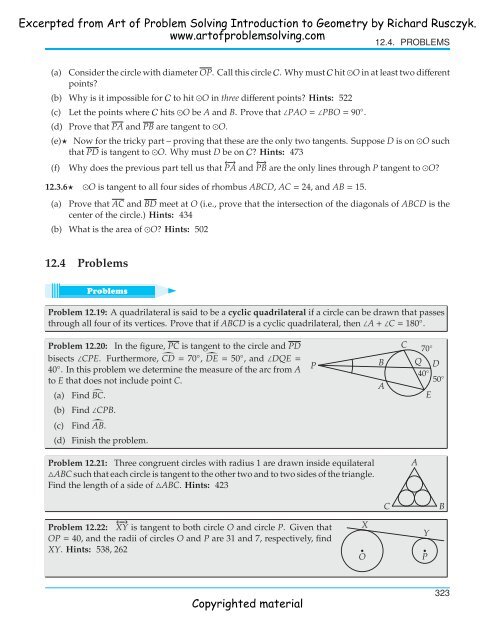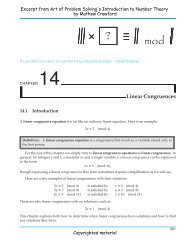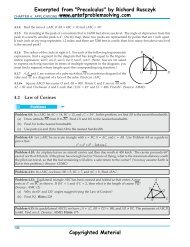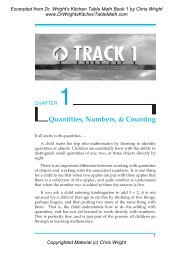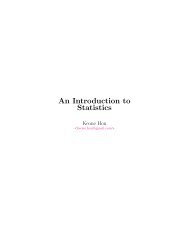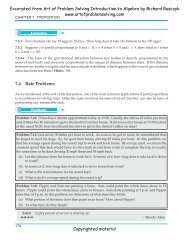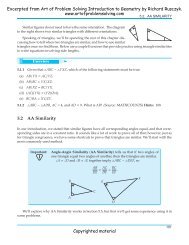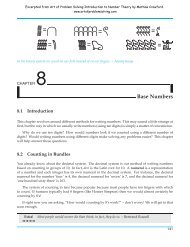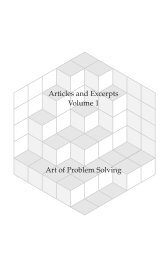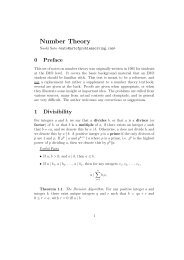Excerpted from Art of Problem Solving Introduction to Geometry
Excerpted from Art of Problem Solving Introduction to Geometry
Excerpted from Art of Problem Solving Introduction to Geometry
You also want an ePaper? Increase the reach of your titles
YUMPU automatically turns print PDFs into web optimized ePapers that Google loves.
<strong>Excerpted</strong> <strong>from</strong> <strong>Art</strong> <strong>of</strong> <strong>Problem</strong> <strong>Solving</strong> <strong>Introduction</strong> <strong>to</strong> <strong>Geometry</strong> by Richard Rusczyk.<br />
www.art<strong>of</strong>problemsolving.com<br />
12.4. PROBLEMS<br />
(a) Consider the circle with diameter OP. Call this circleC. Why mustChit⊙O in at least two different<br />
points?<br />
(b) Why is it impossible forC<strong>to</strong> hit⊙O in three different points? Hints: 522<br />
(c) Let the points whereChits⊙O be A and B. Prove that∠PAO=∠PBO=90 ◦ .<br />
(d) Prove that PA and PB are tangent <strong>to</strong>⊙O.<br />
(e)⋆ Now for the tricky part – proving that these are the only two tangents. Suppose D is on⊙O such<br />
that PD is tangent <strong>to</strong>⊙O. Why must D be onC? Hints: 473<br />
(f) Why does the previous part tell us that ←→<br />
PA and ←→ PB are the only lines through P tangent <strong>to</strong>⊙O?<br />
12.3.6⋆ ⊙O is tangent <strong>to</strong> all four sides <strong>of</strong> rhombus ABCD, AC=24, and AB=15.<br />
(a) Prove that AC and BD meet at O (i.e., prove that the intersection <strong>of</strong> the diagonals <strong>of</strong> ABCD is the<br />
center <strong>of</strong> the circle.) Hints: 434<br />
(b) What is the area <strong>of</strong>⊙O? Hints: 502<br />
12.4 <strong>Problem</strong>s<br />
<strong>Problem</strong>s<br />
<strong>Problem</strong> 12.19: A quadrilateral is said <strong>to</strong> be a cyclic quadrilateral if a circle can be drawn that passes<br />
through all four <strong>of</strong> its vertices. Prove that if ABCD is a cyclic quadrilateral, then∠A+∠C=180 ◦ .<br />
<strong>Problem</strong> 12.20: In the figure, PC is tangent <strong>to</strong> the circle and PD<br />
bisects∠CPE. Furthermore, , CD=70◦ DE=50◦ , and∠DQE=<br />
40◦ . In this problem we determine the measure <strong>of</strong> the arc <strong>from</strong> A<br />
<strong>to</strong> E that does not include point C.<br />
(a) Find BC.<br />
(b) Find∠CPB.<br />
(c) Find AB.<br />
(d) Finish the problem.<br />
<strong>Problem</strong> 12.21: Three congruent circles with radius 1 are drawn inside equilateral<br />
△ABC such that each circle is tangent <strong>to</strong> the other two and <strong>to</strong> two sides <strong>of</strong> the triangle.<br />
Find the length <strong>of</strong> a side <strong>of</strong>△ABC. Hints: 423<br />
<strong>Problem</strong> 12.22: ←→<br />
XY is tangent <strong>to</strong> both circle O and circle P. Given that<br />
OP=40, and the radii <strong>of</strong> circles O and P are 31 and 7, respectively, find<br />
XY. Hints: 538, 262<br />
Copyrighted material<br />
P<br />
X<br />
B<br />
A<br />
C<br />
A<br />
70 ◦<br />
Q<br />
40 ◦<br />
E<br />
D<br />
50 ◦<br />
C B<br />
Y<br />
O P<br />
323
<strong>Excerpted</strong> <strong>from</strong> <strong>Art</strong> <strong>of</strong> <strong>Problem</strong> <strong>Solving</strong> <strong>Introduction</strong> <strong>to</strong> <strong>Geometry</strong> by Richard Rusczyk.<br />
www.art<strong>of</strong>problemsolving.com<br />
CHAPTER 12. CIRCLES AND ANGLES<br />
<strong>Problem</strong> 12.23: Median AM <strong>of</strong>△ABC has length 8. Given that BC=16 and AB=9, find the area <strong>of</strong><br />
△ABC. Hints: 21, 182<br />
<strong>Problem</strong> 12.24: The diagram shows the incircle <strong>of</strong>△ABC. X, Y, and Z are the<br />
points <strong>of</strong> tangency where the incircle <strong>to</strong>uches the triangle. In this problem<br />
we will find an expression for AZ in terms <strong>of</strong> the sides <strong>of</strong> the triangle.<br />
(a) Find equal segments in the diagram and assign them variables.<br />
(b) Let AB=c, AC=b, and BC=a. Use your variables <strong>from</strong> the first part<br />
<strong>to</strong> write equations that include these lengths.<br />
(c) Solve your resulting equations for AZ. Hints: 152<br />
Z<br />
A<br />
Y<br />
B C<br />
X<br />
We’ll now apply our knowledge <strong>of</strong> circles, angles, and tangents <strong>to</strong> more challenging problems and<br />
develop some useful geometric concepts.<br />
<strong>Problem</strong> 12.19: A quadrilateral is said <strong>to</strong> be a cyclic quadrilateral if a circle can be drawn that passes<br />
through all four <strong>of</strong> its vertices. Prove that if ABCD is a cyclic quadrilateral, then∠A+∠C=180 ◦ .<br />
Solution for <strong>Problem</strong> 12.19: Since∠A and∠C are inscribed angles, we have<br />
<br />
∠A+∠C= BCD<br />
2 + BAD<br />
2 = BCD+ BAD<br />
=<br />
2<br />
360◦<br />
2 = 180◦ .<br />
Important: A quadrilateral is a cyclic quadrilateral if a circle can be drawn that<br />
passes through all four <strong>of</strong> its vertices. Such a quadrilateral is said <strong>to</strong> be<br />
inscribed in the circle. The opposite angles <strong>of</strong> any cyclic quadrilateral<br />
sum <strong>to</strong> 180 ◦ .<br />
You’ll be seeing a lot more <strong>of</strong> cyclic quadrilaterals when you move in<strong>to</strong> more advanced geometry.<br />
<strong>Problem</strong> 12.20: In the figure, PC is tangent <strong>to</strong> the circle and<br />
PD bisects∠CPE. If CD=70 ◦ , DE=50 ◦ , and∠DQE=40 ◦ ,<br />
then determine the measure <strong>of</strong> the arc <strong>from</strong> A <strong>to</strong> E that does not<br />
include point C.<br />
Solution for <strong>Problem</strong> 12.20: We can’t directly find the desired arc, so we try finding whatever we can.<br />
First, we note that since∠DQE is the average <strong>of</strong> DE and CB, we have CB=30 ◦ . Now that we have CB,<br />
we can find∠CPD:<br />
∠CPD=( CD− CB)/2=20 ◦ .<br />
Since DP bisects∠CPE, we know∠DPE=∠CPD=20 ◦ . Because∠DPE=( DE− AB)/2, we find AB=10 ◦ .<br />
324<br />
Copyrighted material<br />
P<br />
B<br />
A<br />
B<br />
A<br />
C<br />
70 ◦<br />
Q<br />
40 ◦<br />
E<br />
D<br />
D<br />
50 ◦<br />
C
<strong>Excerpted</strong> <strong>from</strong> <strong>Art</strong> <strong>of</strong> <strong>Problem</strong> <strong>Solving</strong> <strong>Introduction</strong> <strong>to</strong> <strong>Geometry</strong> by Richard Rusczyk.<br />
www.art<strong>of</strong>problemsolving.com<br />
12.4. PROBLEMS<br />
Now that we have all the other arcs <strong>of</strong> the circle, we can find our desired arc by subtracting <strong>from</strong><br />
360 ◦ : 360 ◦ − 50 ◦ − 70 ◦ − 30 ◦ − 10 ◦ = 200 ◦ . <br />
Concept: Label all the given information in the problem, and all the information<br />
you find as you find it. This will help you discover new facts about the<br />
problem. For example, your final diagram in the last problem might look<br />
like the figure below. Notice that our various arc measures and angles are<br />
marked, and that the equal angles at P are marked equal.<br />
70◦ C<br />
P<br />
20 ◦<br />
20 ◦<br />
<strong>Problem</strong> 12.21: Three congruent circles with radius 1 are drawn inside equilateral△ABC such that<br />
each circle is tangent <strong>to</strong> the other two and <strong>to</strong> two sides <strong>of</strong> the triangle. Find the length <strong>of</strong> a side <strong>of</strong><br />
△ABC.<br />
Solution for <strong>Problem</strong> 12.21: We need <strong>to</strong> create simple figures <strong>to</strong> work<br />
A<br />
with, so we start by connecting the centers <strong>of</strong> our circles and drawing<br />
radii <strong>to</strong> tangent points. (Note that connecting the centers <strong>of</strong> the circles<br />
is the same as drawing radii <strong>to</strong> where the circles are tangent.) Since<br />
WXYZ is a rectangle (because XW= YZ, XW YZ, and∠XWZ=90<br />
X<br />
Y<br />
C B<br />
W Z<br />
◦ ),<br />
we have WZ=XY=2. Hence, we need only find CW <strong>to</strong> finish, since<br />
BZ is the same as CW.<br />
We draw CX <strong>to</strong> build a right triangle and note that this segment<br />
bisects∠ACB because circle X is tangent <strong>to</strong> both AC and BC (and hence<br />
its center is equidistant <strong>from</strong> them). Since∠XCW=(∠ACB)/2=30◦ ,<br />
△CXW is a 30-60-90 triangle. Thus, CW= XW √ 3= √ 3. Finally, we have BC=BZ+ZW+WC=2+2 √ 3.<br />
<br />
B<br />
10 ◦<br />
A<br />
30 ◦<br />
200 ◦<br />
Q<br />
40 ◦<br />
Concept: When you have tangents in a problem, it’s <strong>of</strong>ten very helpful <strong>to</strong> draw radii<br />
<strong>to</strong> points <strong>of</strong> tangency <strong>to</strong> build right triangles. When you have tangent<br />
circles, connect the centers. (In fact, if you have multiple circles in a<br />
problem, connecting the centers will sometimes help even when the circles<br />
aren’t tangent.)<br />
<strong>Problem</strong> 12.22: X is on circle O and Y on circle P such that ←→<br />
XY is tangent <strong>to</strong> both circles. Given that<br />
OP=40, and the radii <strong>of</strong> circles O and P are 31 and 7, respectively, find XY.<br />
Copyrighted material<br />
E<br />
D<br />
50 ◦<br />
325
<strong>Excerpted</strong> <strong>from</strong> <strong>Art</strong> <strong>of</strong> <strong>Problem</strong> <strong>Solving</strong> <strong>Introduction</strong> <strong>to</strong> <strong>Geometry</strong> by Richard Rusczyk.<br />
www.art<strong>of</strong>problemsolving.com<br />
CHAPTER 12. CIRCLES AND ANGLES<br />
Solution for <strong>Problem</strong> 12.22: We start with the usual segments <strong>to</strong> X<br />
draw: XY, the radii <strong>to</strong> points <strong>of</strong> tangency, and the segment con-<br />
Y<br />
necting the centers. We still don’t have a right triangle <strong>to</strong> work Z<br />
with, but we do know that radii OX and PY are both perpendicular<br />
<strong>to</strong> tangent XY as shown. Since both OX and PY are perpendicular<br />
<strong>to</strong> the same line, they are parallel. We make a right triangle and<br />
O P<br />
a rectangle by drawing a line through P parallel <strong>to</strong> XY. ZX=PY=7, so OZ=OX−ZX=24. Since<br />
OP=40, we have PZ=32 <strong>from</strong> right triangle△OZP. Since XYPZ is a rectangle, we have XY=ZP=32,<br />
so the length <strong>of</strong> the common tangent is 32.<br />
XY is called a common external tangent <strong>of</strong> the two circles. As an Exercise, you’ll find the length <strong>of</strong><br />
the common internal tangent, <strong>to</strong>o. <br />
<strong>Problem</strong> 12.23: Median AM <strong>of</strong>△ABC has length 8. Given that BC=16 and AB=9, find the area <strong>of</strong><br />
△ABC.<br />
Solution for <strong>Problem</strong> 12.23: When we draw the figure and label all our lengths,<br />
we see that BM = AM = CM = 8. Therefore, a circle centered at M with<br />
radius 8 goes through all three vertices <strong>of</strong>△ABC. Since BC is a diameter <strong>of</strong> this<br />
circle,∠BAC is inscribed in a semicircle and therefore must be a right angle.<br />
So, AC= √ BC 2 − AB 2 = 5 √ 7. △ABC is a right triangle, so its area is half the<br />
product <strong>of</strong> its legs:<br />
<br />
[ABC]= (AB)(AC)<br />
2<br />
= (9)(5√ 7)<br />
2<br />
= 45√7 .<br />
2<br />
Using this same reasoning, we can also prove this important fact:<br />
Important: If the length <strong>of</strong> a median <strong>of</strong> a triangle is half the length <strong>of</strong> the side <strong>to</strong> which<br />
it is drawn, the triangle must be a right triangle. Moreover, the side <strong>to</strong><br />
which this median is drawn is the hypotenuse <strong>of</strong> the right triangle.<br />
We can also look <strong>to</strong> this problem for some important problem solving techniques:<br />
Concept: When stuck on a problem, always ask yourself ‘Where have I seen something<br />
like this before?’ In <strong>Problem</strong> 12.23, we have a median that is half<br />
the side <strong>to</strong> which it is drawn. This should make us think <strong>of</strong> right triangles,<br />
since the median <strong>to</strong> the hypotenuse <strong>of</strong> a right triangle is half the<br />
hypotenuse. Then we go looking for right triangles.<br />
Concept: Always be on the lookout for right triangles.<br />
<strong>Problem</strong> 12.24: Let Z be the point where the incircle <strong>of</strong>△ABC meets AB. Find AZ in terms <strong>of</strong> the<br />
sides <strong>of</strong>△ABC.<br />
326<br />
Copyrighted material<br />
B<br />
A<br />
M<br />
C
<strong>Excerpted</strong> <strong>from</strong> <strong>Art</strong> <strong>of</strong> <strong>Problem</strong> <strong>Solving</strong> <strong>Introduction</strong> <strong>to</strong> <strong>Geometry</strong> by Richard Rusczyk.<br />
www.art<strong>of</strong>problemsolving.com<br />
Solution for <strong>Problem</strong> 12.24: We start by labeling the equal tangents<br />
<strong>from</strong> the vertices as shown in the diagram. We want <strong>to</strong> relate x <strong>to</strong> the<br />
sides <strong>of</strong> the triangle, so we write the sides <strong>of</strong> the triangle in terms <strong>of</strong><br />
x, y, and z. We let the sides <strong>of</strong> the triangle be AB=c, AC=b, and<br />
BC=aand we have:<br />
AB = c = x+ y<br />
AC = b = x+z<br />
BC = a = y+z<br />
y<br />
Z<br />
x<br />
A<br />
12.4. PROBLEMS<br />
x<br />
B<br />
y<br />
C<br />
X z<br />
We want x in terms <strong>of</strong> a, b, and c. Adding the three equations will give us x+ y+z, which we can<br />
use with y+z=a<strong>to</strong> find x:<br />
a+b+c=2(x+ y+z) so x+ y+z= a+b+c<br />
.<br />
2<br />
We can then subtract the equation y+z=a<strong>from</strong> x+ y+z=(a+b+c)/2 <strong>to</strong> find<br />
x= a+b+c<br />
2<br />
− a=s−a,<br />
where s is the semiperimeter (half the perimeter) <strong>of</strong> the triangle. Similarly, y=s−b and z=s−c. <br />
Concept: Symmetric systems <strong>of</strong> equations can <strong>of</strong>ten be easily solved by either multiplying<br />
all the equations or adding them.<br />
Important: The lengths <strong>from</strong> the vertices <strong>of</strong><br />
△ABC <strong>to</strong> the points <strong>of</strong> tangency <strong>of</strong><br />
A<br />
its incircle are given as follows:<br />
s−a<br />
Exercises<br />
AZ = AY = s−a<br />
BZ = BX = s−b<br />
CX = CY = s−c<br />
where AB=c, AC=b, and BC=a,<br />
and the semiperimeter <strong>of</strong>△ABC is s.<br />
s−b<br />
Z<br />
s−a<br />
Y<br />
B C<br />
s−b X s−c<br />
<strong>Problem</strong>s 12.4.3, 12.4.4, 12.4.5, and 12.4.8 are very important relationships that you’ll be seeing again<br />
in your study <strong>of</strong> more advanced geometry. Be sure <strong>to</strong> pay special attention <strong>to</strong> them.<br />
12.4.1 Is every quadrilateral cyclic?<br />
12.4.2 Prove the following about cyclic quadrilaterals:<br />
(a) A cyclic parallelogram must be a rectangle.<br />
(b) A cyclic rhombus must be a square.<br />
(c) A cyclic trapezoid must be isosceles.<br />
Copyrighted material<br />
Y<br />
s−c<br />
z<br />
327
<strong>Excerpted</strong> <strong>from</strong> <strong>Art</strong> <strong>of</strong> <strong>Problem</strong> <strong>Solving</strong> <strong>Introduction</strong> <strong>to</strong> <strong>Geometry</strong> by Richard Rusczyk.<br />
www.art<strong>of</strong>problemsolving.com<br />
CHAPTER 12. CIRCLES AND ANGLES<br />
12.4.3 Prove that if median XM <strong>of</strong>△XYZ has half the length <strong>of</strong> YZ, then△XYZ is a right triangle with<br />
hypotenuse YZ.<br />
12.4.4 ABCD is a cyclic quadrilateral. Prove that∠ACB=∠ADB.<br />
A<br />
D<br />
B<br />
C<br />
12.4.5 Quadrilateral ABCD in the diagram at left is a circumscribed quadrilateral,<br />
meaning that it is circumscribed about a circle, so the circle is tangent <strong>to</strong> all<br />
four sides <strong>of</strong> ABCD. Show that AB+CD=BC+AD. Hints: 559<br />
12.4.6 Does every quadrilateral have an inscribed circle (a circle tangent <strong>to</strong> all<br />
four sides), as ABCD does in the previous problem?<br />
12.4.7 In the figure at right, AB is tangent <strong>to</strong> both⊙O and⊙P. The radius <strong>of</strong>⊙O<br />
is 8, the radius <strong>of</strong>⊙P is 4, and OP=36. find AB. (A common tangent like AB is<br />
sometimes called the common internal tangent <strong>of</strong> two circles.) Hints: 578<br />
12.4.8 Prove that the inradius <strong>of</strong> a right triangle with legs <strong>of</strong> length a and b and<br />
hypotenuse c is (a+b−c)/2.<br />
B A<br />
C<br />
D<br />
12.4.9⋆ The five circles in the diagram are congruent and ABCD is a square with<br />
side length 4. The four outer circles are each tangent <strong>to</strong> the middle circle and <strong>to</strong> the<br />
square on two sides as shown. Find the radius <strong>of</strong> each <strong>of</strong> the circles. Hints: 534, 411<br />
12.5 Construction: Tangents<br />
Now you’ll use your newfound tangent knowledge <strong>to</strong> construct tangents <strong>to</strong> circles.<br />
<strong>Problem</strong>s<br />
<strong>Problem</strong> 12.25: Given a circle with center O and point A on the circle, construct a line through A that<br />
is tangent <strong>to</strong> the circle.<br />
<strong>Problem</strong> 12.26: Given a circle with center O and point P outside the circle, construct a line through P<br />
that is tangent <strong>to</strong> the circle.<br />
<strong>Problem</strong> 12.27: Nonintersecting circles with centers O and P are shown.<br />
Construct a line that is tangent <strong>to</strong> both circles.<br />
328<br />
Extra!<br />
➠➠➠➠<br />
Seek simplicity, and distrust it.<br />
Copyrighted material<br />
O<br />
A<br />
B<br />
O P<br />
–Alfred North Whitehead<br />
P


